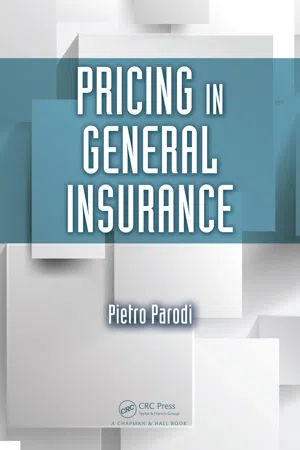
This is a test
- 584 pages
- English
- PDF
- Available on iOS & Android
eBook - PDF
Pricing in General Insurance
Book details
Book preview
Table of contents
Citations
About This Book
Based on the syllabus of the actuarial industry course on general insurance pricing- with additional material inspired by the author's own experience as a practitioner and lecturer- Pricing in General Insurance presents pricing as a formalised process that starts with collecting information about a particular policyholder or risk and ends with a co
Frequently asked questions
At the moment all of our mobile-responsive ePub books are available to download via the app. Most of our PDFs are also available to download and we're working on making the final remaining ones downloadable now. Learn more here.
Both plans give you full access to the library and all of Perlego’s features. The only differences are the price and subscription period: With the annual plan you’ll save around 30% compared to 12 months on the monthly plan.
We are an online textbook subscription service, where you can get access to an entire online library for less than the price of a single book per month. With over 1 million books across 1000+ topics, we’ve got you covered! Learn more here.
Look out for the read-aloud symbol on your next book to see if you can listen to it. The read-aloud tool reads text aloud for you, highlighting the text as it is being read. You can pause it, speed it up and slow it down. Learn more here.
Yes, you can access Pricing in General Insurance by Pietro Parodi in PDF and/or ePUB format, as well as other popular books in Business & Finance. We have over one million books available in our catalogue for you to explore.

15
Pricing
Process
Claims
experience
and
historical
exposure
are
as
follows:
Fiscal
year
(1/4)
Number
of
pubs
2009/10
2010/11
2011/12
2012/13
2013/14
2014/15
653
711
698
702
710
720
Policy
year
(1/10)
Total
paid
Total
O/S
Recoveries
2009/2010
2010/2011
2011/2012
2012/2013
2013/2014
Grand
total
9,440,692
1,590,430
102,715
3,266,198
3,148,272
1,608,092
1,324,927
93,203
4617
21,182
589,309
975,322
97,381
728
1987
2619
–
–
Data
as
of
12
June
2014.
The
historical
amount
of
each
claim
is
split
into
a
paid
component,
an
outstanding
(O/S)
component
and
recoveries
from
a
third
party.
The
overall
incurred
amount
is
therefore
Incurred
=
Paid
+
Outstanding
−
Recoveries.
Also
consider
(or
not)
that
from
2011
onwards,
a
new
smoke
detection
system
had
been
installed
that,
according
to
the
manufacturer,
would
decrease
by
20%
the
probability
that
a
fire
turns
into
an
actual
loss.
By
assuming
a
4%
claims
inflation
for
property
claims
and
by
making
sensible
(and
explicit)
assumptions
about
everything
else
as
needed,
estimate
the
technical
premium
for
policy
year
2014/2015.
Explain
the
limitations
of
your
analysis.
2.
Explain
the
relative
merits
of
using
the
number
of
employees
(or
employee-years)
and
wageroll
as
measures
of
exposure
for
employers’
liability
for
pricing
purposes.

Table of contents
- Front Cover
- Contents
- Preface
- Acknowledgements
- Chapter 1: Pricing Process: A Gentle Start
- Chapter 2: Insurance and Reinsurance Products
- Chapter 3: The Policy Structure
- Chapter 4: The Insurance Markets
- Chapter 5: Pricing in Context
- Chapter 6: The Scientific Basis for Pricing: Risk Loss Models and the Frequency/Severity Risk Costing Process
- Chapter 7: Familiarise Yourself with the Risk
- Chapter 8: Data Requirements for Pricing
- Chapter 9: Setting the Claims Inflation Assumptions
- Chapter 10: Data Preparation
- Chapter 11: Burning Cost Analysis
- Chapter 12: What Is This Thing Called Modelling?
- Chapter 13: Frequency Modelling: Adjusting for Claim Count IBNR
- Chapter 14: Frequency Modelling: Selecting and Calibrating a Frequency Model
- Chapter 15: Severity Modelling: Adjusting for IBNER and Other Factors
- Chapter 16: Severity Modelling: Selecting and Calibrating a Severity Model
- Chapter 17: Aggregate Loss Modelling
- Chapter 18: Identifying, Measuring and Communicating Uncertainty
- Chapter 19: From Costing to Pricing
- Chapter 20: Experience Rating for Non-Proportional Reinsurance
- Chapter 21: Exposure Rating for Property
- Chapter 22: Liability Rating Using Increased Limit Factor Curves
- Chapter 23: Pricing Considerations for Specific Lines of Business
- Chapter 24: Catastrophe Modelling
- Chapter 25: Credibility Theory
- Chapter 26: Rating Factor Selection and Generalised Linear Modelling
- Chapter 27: Multilevel Factors and Smoothing
- Chapter 28: Pricing Multiple Lines of Business and Risks
- Chapter 29: Insurance Structure Optimisation
- References
- Back Cover